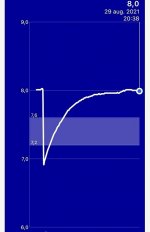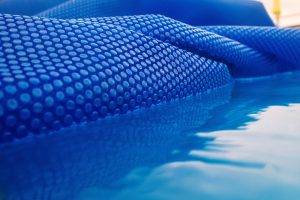Hi
I'm seeking some advice on some severe pH problems.
If anyone is able to come up with a solution for what is basically a chemistry problem, I would be very grateful.
Basics:
I have a too high pH in my pool of 8.0.
I can adjust it with normal pH lowering product which I expect is sodium bisulphate.
It goes down as expected.
But then it goes back up to 8.0 (see picture, time scale is 1 week)
ORP goes up as expected when pH goes down.
I do have a salt chlorinator but it was turned off during the measurement period.
No other chemicals have been added during this period.
Other than pH being high, the pool water is clean and nice.
I can repeat the same adjustment with the same end results every time.
More information:
pH probe is calibrated.
Water measurement has been done by an accredited laboratory which confirms pH reading.
Laboratory also reports the following chemical levels:
(all in ppm unless otherwise specified)
Alkalinity, HCO3: 57
NH4-N: 0
NH4: 0
NO3-N: 2.7
NO2-N: 0
NO2: 0
PO4-P: 0.072
PO4: 0.22
F: 0.13
SO4: 330
Fe: 0
Ca: 51
K: 7.0
Cu: 0
Mg: 5.0
Mn: 0
Na: 1500
CaCO3: 150 (translated from hardness)
Free chlorine as measured by simple aquacheck sticks is 0 - 0.5.
CYA is 0.
I can't really wrap my head around this.
What on earth is causing pH to go back up?
I'm seeking some advice on some severe pH problems.
If anyone is able to come up with a solution for what is basically a chemistry problem, I would be very grateful.
Basics:
I have a too high pH in my pool of 8.0.
I can adjust it with normal pH lowering product which I expect is sodium bisulphate.
It goes down as expected.
But then it goes back up to 8.0 (see picture, time scale is 1 week)
ORP goes up as expected when pH goes down.
I do have a salt chlorinator but it was turned off during the measurement period.
No other chemicals have been added during this period.
Other than pH being high, the pool water is clean and nice.
I can repeat the same adjustment with the same end results every time.
More information:
pH probe is calibrated.
Water measurement has been done by an accredited laboratory which confirms pH reading.
Laboratory also reports the following chemical levels:
(all in ppm unless otherwise specified)
Alkalinity, HCO3: 57
NH4-N: 0
NH4: 0
NO3-N: 2.7
NO2-N: 0
NO2: 0
PO4-P: 0.072
PO4: 0.22
F: 0.13
SO4: 330
Fe: 0
Ca: 51
K: 7.0
Cu: 0
Mg: 5.0
Mn: 0
Na: 1500
CaCO3: 150 (translated from hardness)
Free chlorine as measured by simple aquacheck sticks is 0 - 0.5.
CYA is 0.
I can't really wrap my head around this.
What on earth is causing pH to go back up?





